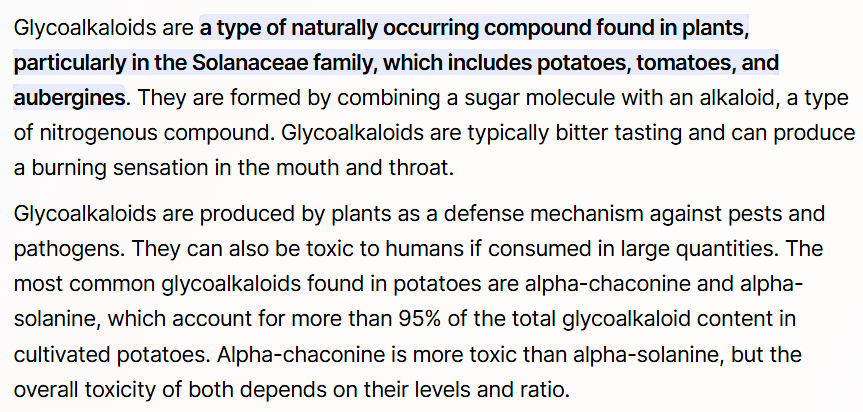Although the ability of xenobiotics [toxins] to induce clinical illness is well established, the expanding public health problem of widespread toxicant exposure in the general population is a relatively new phenomenon that has spawned escalating concern. The emerging area of clinical care involving the assessment and management of accrued toxic substances such as heavy metals, pesticides, plasticizers and other endocrine disrupting or neurotoxic compounds has not been fully appreciated by the medical community and has yet to be incorporated into the clinical practice of many consultants or primary care practitioners.
https://pubmed.ncbi.nlm.nih.gov/18621076/
Many conditions of toxicity can leave us tired or with mostly physical symptoms. That toxicity can be from any of a number of factors or an accumulation of them (foods, modern airborne chemical vapors, etc). It's not so much the toxicity of any one thing as it is the overall burden upon the liver and our detoxification anatomy.
But when toxicity noticeably affects mood, behavior, or mental clarity it can be mistaken for a psychiatric condition. Even the lethargy of exhaustion has been mistakenly interpreted by MDs as 'depression'.
Too many people are being diagnosed as 'mentally ill' who have actually encountered a neurotoxin. Poisonings can come from foods, plants, drugs, or water taken directly into the body. Also from the airborne factors in our daily home, work, or neighborhood environments.
Many types of poisonings create alterations of brain and nerve function dramatically enough to alter moods and behaviors. Here are some of the well documented.
Ergotism, St. Anthony's Fire
Ergot poisoning is mostly a thing of the past, but it is a very instructive example.
Symptoms of ergot poisoning can appear as a prolonged intoxication. It can include hallucinations, a dazed condition, inability to speak, or mania, usually with other physical symptoms (burning sensations or sensations under the skin).
It has been proposed that ergot poisoning could account for the witch hysteria that drove countless witch hunts through the dark and middle ages.
https://www.britannica.com/story/how-rye-bread-may-have-caused-the-salem-witch-trials
Ergot alkaloids are neurotoxins.
Datura poisoning
Datura got popularized beginning with the publication of The Teachings of Don Juan by Carlos Castaneda (1968). I had a copy of this book myself and it is one of my favorite (fictional) stories.
The plant is known as Jimsonweed, Devil’s Weed, Devil’s Trumpets, Thorn Apple, and Moon Flower. It is a member of the nightshade family and its flowers are gorgeous, odorous, and seductive. And they can be toxic to the touch.
These plants contain significant amounts of atropine, hyoscyamine, and scopalamine, which can cause delirium and hallucinations considered similar to dissociative disorder and schizophrenia. In the American colonies this was described in the Jamestown incident: https://wydaily.com/news/local/2021/10/22/oddities-curiosities-the-colonial-case-of-the-mysterious-jimson-weed/
Fortunately, homeopaths saw fit a long time ago to incorporate Datura stramonium into their materia medica as the remedy Stramonium. It is an effective antidote to Datura poisonings (and conditions presenting similarly) when used at the 30c potency or higher. Stramonium description in the Boericke materia medica.
Poisoning from other plants
The nightshade family is now well known for its toxic members and plant parts. We eat beautiful red ripe tasty tomatoes, but would never eat the leaves or stems which are full of solanines that are very toxic. But occasionally, someone will ingest too many potatoes with green spots (indicating solanines) and get sick.
Far worse is poisoning from Black Henbane or Belladonna. The symptoms are akin to Datura poisoning.
All nightshades contain these glycoalkaloids.
Toxic metals (mercury, etc)
Poisonings due to consumption of seeds treated with mercury compounds are sometimes misidentified as ergotism. There have been numerous cases of mass-poisoning due to consumption of mercury-treated seeds. https://en.wikipedia.org/wiki/Ergotism#History
Mercury (quicksilver) is volatile, evaporating at room temperature, and extremely toxic in very small amounts. Mercury poisoning with even a tiny amount can become chronic because its volatility means that at core body temperatures it tends to move back up into the brain tissues.
Symptoms of mercury toxicity can be quite complex and subtle. Symptoms can include joint pain, muscle pain, weakness, fatigue, neuropathy, neuritis, hypertension, tachycardia, excessive salivation, sweating, insomnia, depression, skin rashes, kidney swelling, burning ruination, and other issues.
The homeopathic literature gives a good summary of the syndrome with the most reliable remedy being the homeopathic dilution and potentization, Mercurius solubis.
Common sources of mercury poisonings are:
mercury amalgam dental fillings
thermometers
school science labs
broken fluorescent light tubes, including compact fluorescent ‘curly q’ bulbs
‘herbal’ or OTC remedies that bypass modern regulations
cell phones
Knowing if you have encountered any sources of mercury in recent months is the most important factor in knowing whether your symptoms are from mercury.
Mercury-amalgam dental fillings are usually about 50% mercury. They are the primary cause of chronic and unrecognized mercury poisonings. These fillings will begin to break down after about 20 years and release mercury and other metals into the body.
I had my own mercury-amalgam filling removed in 2002 when I began experiencing headaches, metallic bad breath, and mental confusion. I went to biological dentist, Stephen Evans, who safely removed the mercury filling and replaced it quickly and painlessly with composite filling. I was out of the dentist chair in 20 minutes. Since then I have had no problems.
Earth radiations
Kathe Bachler is an Austrian author of a book called Earth Radiation.
This book details how a bed positioned over certain types of underground streams that emit detrimental radiations can harm a person’s health. The harms often appear to be a psychiatric condition or ‘nerves’, inducing the person’s physician to prescribe psychiatric drugs.
I experienced this (1997-98) after changing the position of my bed and can attest to the accuracy of her description. I experienced a regression into chronic fatigue and a depressive state of health.
A local chiropractor made the determination. I had to move my bed back to its previous location where it had been for many years prior. Then I got better.
Medical drugs
Many pharmaceuticals are neurotoxic — especially psychiatric drugs. Here’s what Dr. Peter Breggin (psychiatrist) says about it …
Very important to consider, especially for those who are taking multiple Rx drugs simultaneously that have never been studied together for long-term for safety. Remember, it is not the normal daily dose of any single substance that may be toxic, but their cumulative effects over time (especially when drugs are combined).
More from Dr. Peter Breggin …
So one of the first suspects in consideration of any possible neurotoxic condition should be any psychiatric or psychoactive drugs a person has taken in recent months or years.
Other drugs
It almost goes without saying that psychoactive street drugs like meth, opioids, especially ‘blues’ (fentanyl-adulterated opiate pills) and fentanyl, ecstasy, and even alcohol and cannabis products can also create toxic conditions that at least temporarily affect mental health or mimic mental illnesses.
You could even say that addiction is a mental illness involving substance abuse, which is cured when the user no longer feels the desire to abuse substances.
It is virtually impossible to determine if a person has a genuine and persistent personality disorder or mental illness unless they are first clean of all toxic substances.
Conclusion
This is not an exhaustive treatment of this issue. I offer it as an introduction to encourage a second look at the explosion in diagnoses of mental illness in recent years.
The medical profession needs better tools and protocols for first determining a person’s possible toxic exposures before leaping to any diagnoses of mental disorders. There’s still too much it-must-be-all-in-their-heads thinking, especially among those wearing the white coats.
We don’t need to be anxious and overly alert to any risks of toxicity. The keys are:
paying more careful attention to our bodies and what they are trying to tell us about possible toxicity or problems with any chemicals, drugs, or substances we ingest.
get more help from practitioners of natural medicine who have experience dealing with ‘mystery illness’ and who don’t make assumptions convenient to only the pharmaceutical companies.












